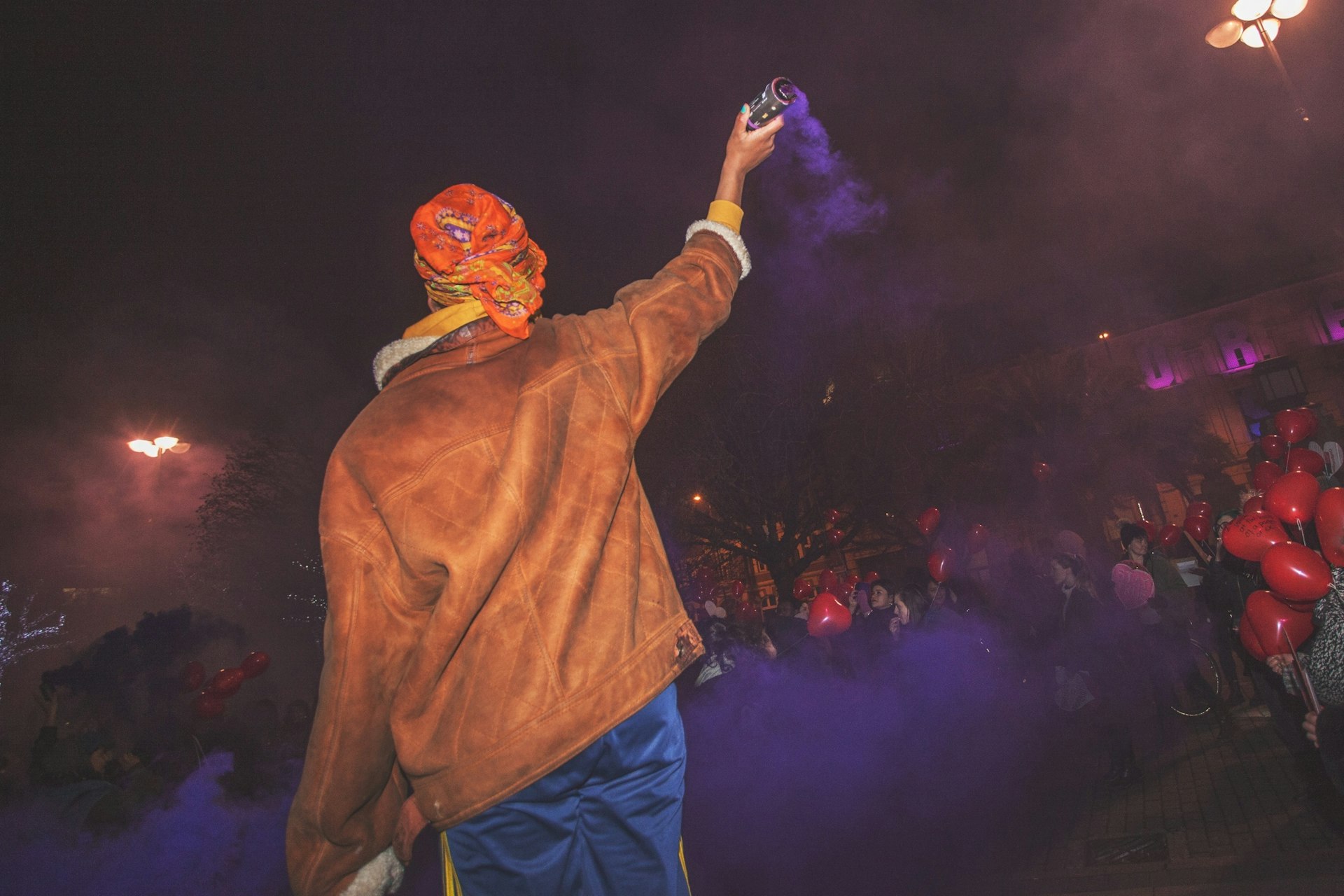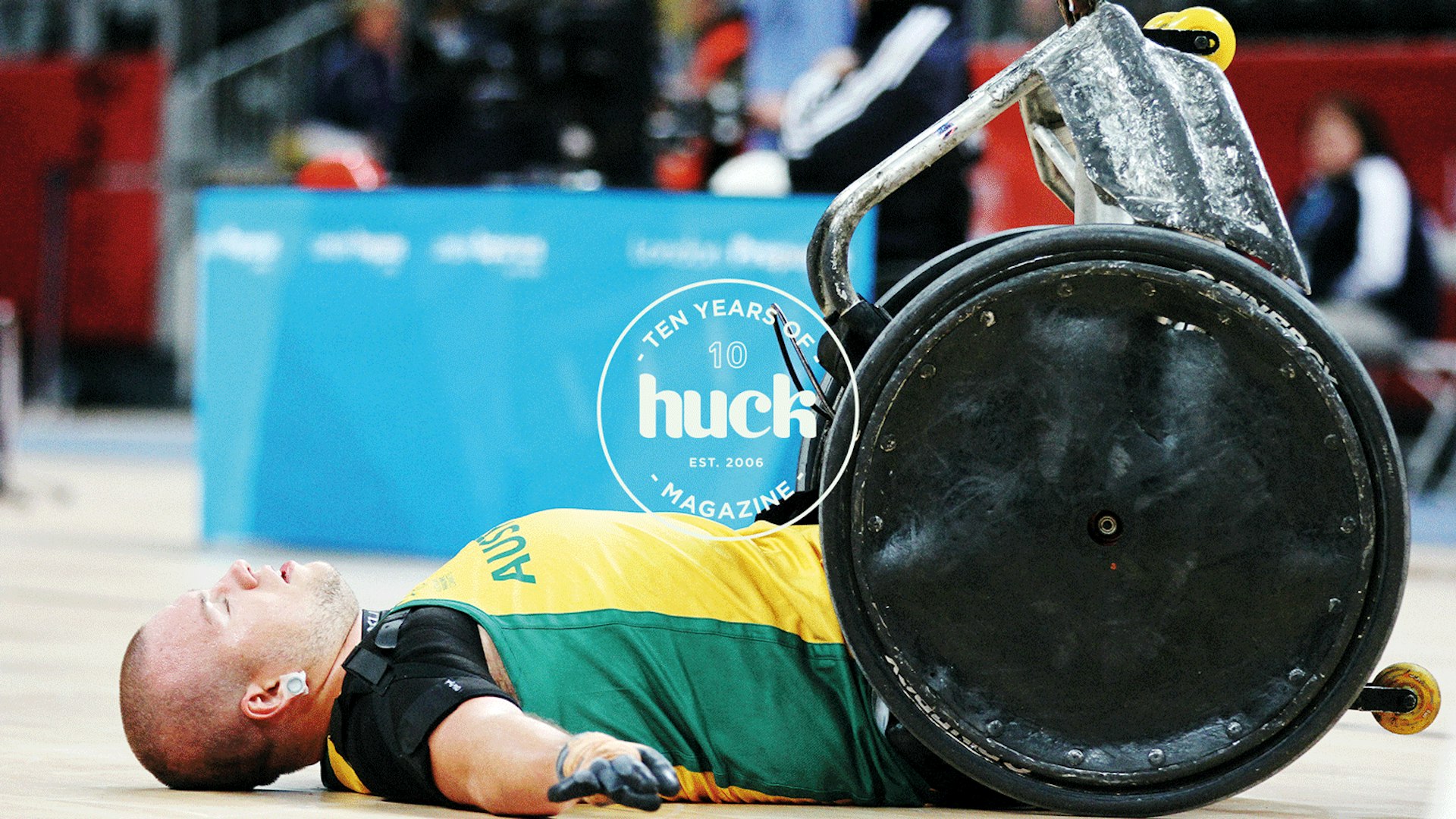
Murderball: Inside the brutal world of wheelchair rugby
- Text by D’Arcy Doran
- Photography by Elizabeth Dalziel
A bang echoes through London’s cavernous Olympic basketball arena as one wheelchair rams into another. Britain’s Aaron Phipps has been hit by a Canadian defender, and for a split-second his left wheel hangs precariously in the air.
Phipps spins into a 180. Escaping with the ball, he carves around another Canadian opponent who’s been expertly blocked by teammate Ross Morrison. Arms pounding like blades on a steam locomotive, he carries the ball across the court and over the goal line to score.
The guards on Phipps’ wheels are battered like comets; a history of hits, both taken and received. This is the world of wheelchair rugby – the Paralympics’ only full-contact sport and its fastest selling ticket.
It’s also one of few sports where a welder stands by, ready to reassemble the Mad Max-style wheelchairs that provide a second skin for the athletes battling it out on the court.
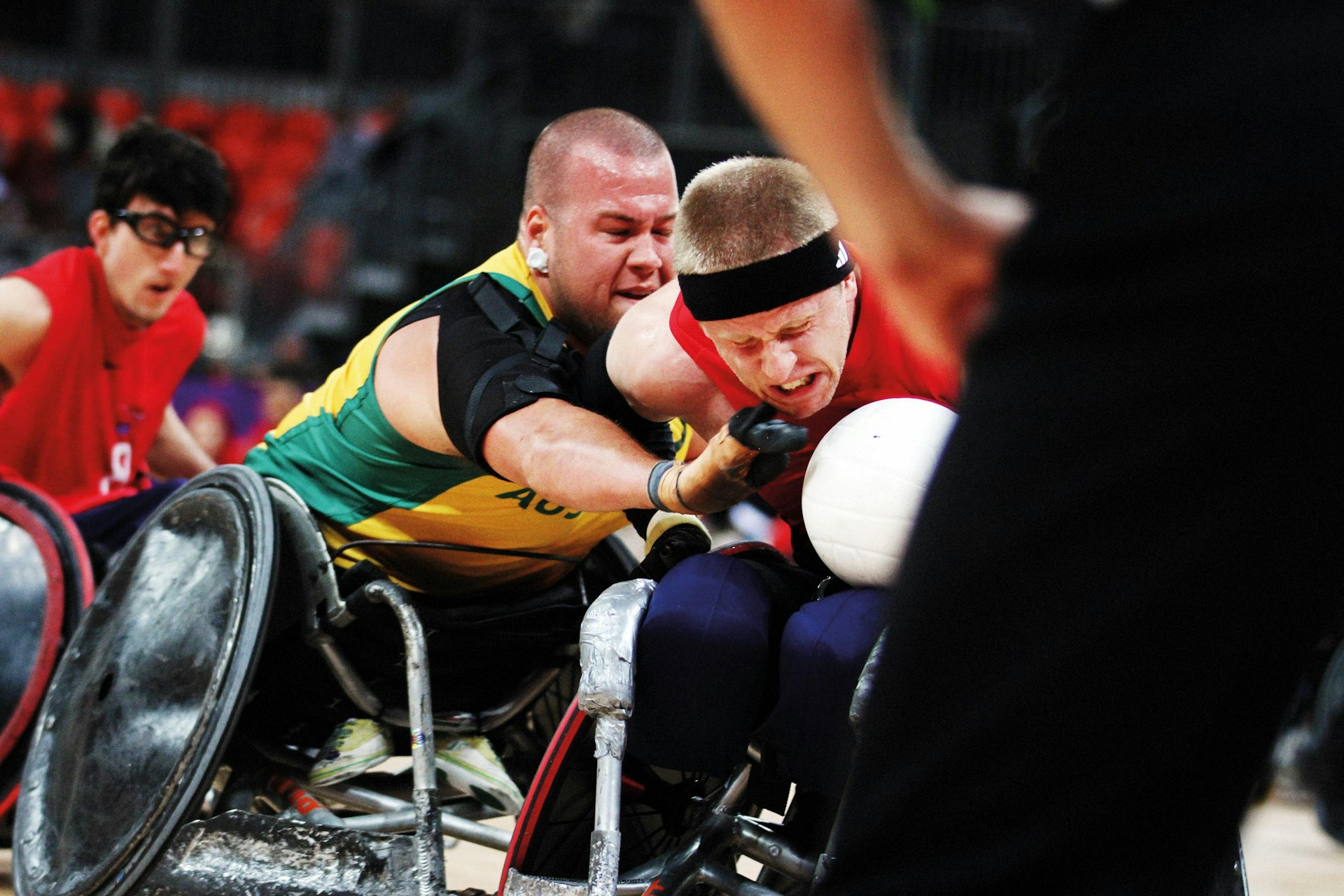
Originally called murderball, the sport was invented by Canadian quadriplegics who were frustrated because they couldn’t play wheelchair basketball. It became a Paralympic sport in 2000.
Played on a basketball court with four on a side, it’s a fast, high-scoring game that borrows from rugby, handball and ice hockey. All players are classified as quadriplegics. Some were born disabled, but most came to the game after an accident or illness knocked their lives sideways.
Britain – aka Team GB – has twice come heartbreakingly close to a medal after losing bronze medal matches in Beijing and Athens. At the London Games, the home team is determined to break that streak.
This test event, in April, is a chance for Britain, Canada, Sweden and Australia to scuff up the Olympic basketball court, and for Team GB, ranked six in the world, to test their podium potential ahead of September’s Games. In Beijing, it was Canada that beat them in the bronze medal match. But today, Canada is struggling to handle one of the biggest additions to Team GB’s arsenal: No. 13, Aaron Phipps.
Dangerman. Man on fire. One-man wrecking machine. These are just a few of the names the announcer uses to describe Phipps in the hard-fought game against Canada.
The DJ running the arena’s sound system, having picked up on the nickname bandied about by Phipps’ team mates, decides to play ‘Monster’ by Welsh band The Automatic each time he scores. The song plays forty-five times during the 63-62 win over Canada.
There is no sign of the ferocity shown on court when Phipps opens the door to his home in Southampton. The 29-year-old is out of his wheelchair, wearing glasses and carpenters’ kneepads over his jeans where his legs were amputated.
“It’s easier to chase after Ella without the chair,” he says, introducing his nine-month-old daughter.
Inside, a large aquarium houses his pet African Cichleys, smart and aggressive fish that Phipps loves for the way they dart and attack. In front of the aquarium sits his new rugby chair for the Paralympics.
Shorter than his old chair, it’s faster but also more unstable. It’s designed to make it easier to go up on one wheel so he can squeeze through tight spots.
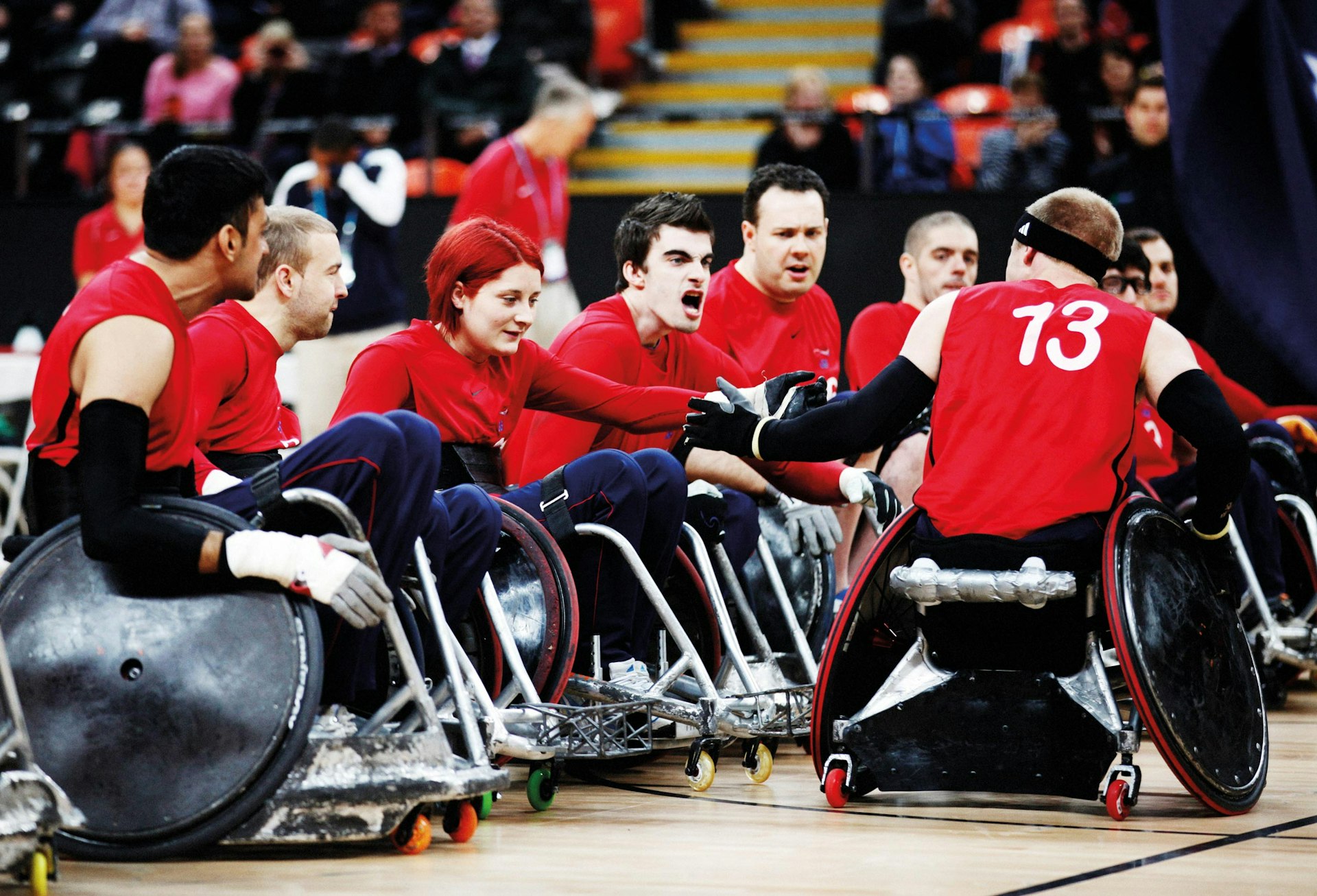
Phipps digs out a photo of himself at fourteen, a year before he fell ill and lost his legs. He’s on inline skates, grinding a rail in a shopping centre parking lot. The photo is striking because it both seems like it’s from another life and hints at the athlete he would become.
The wheels of his skates are nearly identical to those on the chair in the hall and the black padded gloves could be the same ones he uses to propel himself across the court, twenty metres in five seconds.
The photo, he says, was probably snapped just before a security guard chased them away. He and his friends had campaigned for a skatepark in the city. By the time it was built, Phipps had lost his legs. “If I could have my legs back for one day, I would go rollerblading,” he says.
Phipps’ life took a turn when meningitis struck him like lightning. He came home from school the day of the Christmas holiday feeling like he had the flu and the next morning he collapsed on his way to the bathroom.
A doctor rushed to the house and immediately called an ambulance. Within an hour, Phipps was on life support. Doctors gave him a twenty per cent chance of surviving and told his parents to say their goodbyes. But he fought through it. He fell into a coma for two weeks and remained in hospital for a year.
His legs and fingers went black as a blood disease attacked his body. At first he thought just his toes would be amputated, then his feet, but he ended up losing his legs below the knees. As for his hands, he didn’t know what would happen.
“It was horrible. To take off your bandages and see your hands like this,” he says, looking at his fingers, which were all amputated near the first joint.
“You cry your tears and get on with it. But now I look at it and think, ‘Blimey, I’m glad they’re like this.’ If I had much more I wouldn’t be able to play rugby. Really.”
In the hospital, people tried to offer reassurance, telling him one day he would run marathons in artificial legs. “I kept saying, ‘I don’t want to run marathons,’” says Phipps, who was determined to not let the illness define him. He kept going out with friends, graduated, and got an HR job at a supermarket where he met his wife Vicky.
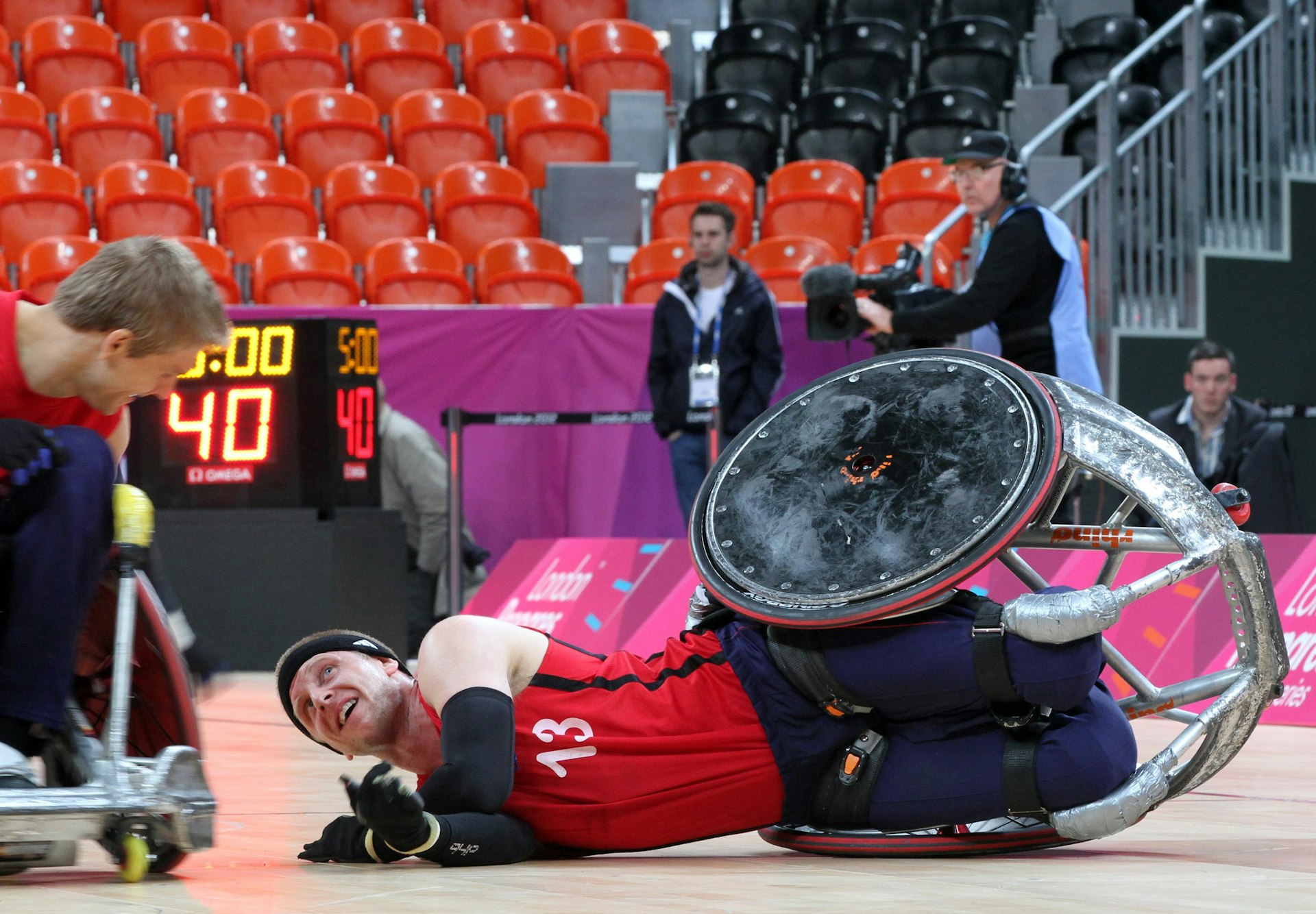
“Then I had a kind of mid-life crisis in my early twenties and I realised this is it,” he says. “I just had a bit of a head-bake really — coming to terms with the fact that you are going to die, but you’ve got to make the best of what you’ve got while you are here. But I wasn’t sure what I wanted to do.”
It was Vicky who encouraged him to try sports. The scarring on his legs meant artificial legs were too painful so wheelchair sports were his only option. He started playing wheelchair basketball — badly. He couldn’t grip or control the ball with his hands.
Then he entered a 10 kilometre race to raise money for meningitis research. The other runners all overtook him, but he loved it. So, he bought a second-hand racing chair and, on a friend’s suggestion, entered the London Marathon. He had no idea what to expect. Then, halfway through, his chair broke.
“It went rip just under the ‘Mile 13’ sign and my bum dropped down about two inches,” he remembers. “It’s really tight in a racing wheelchair so I started getting a really bad cramp in my ass. I was thinking, ‘Why am I doing this?”
Vicky spotted him at mile 22, snaking down the road as if he were delirious, his head hitting the wheelchair’s crossbar. But then as he crossed the finish line and saw his time – two and a half hours – he decided he could improve on that.
“It goes back to that thing about wanting to achieve something,” he says. He returned the next year in a new chair and, after training six days a week, he cut thirty minutes off his time.
It was through racing that Phipps came to rugby. In 2009, while racing in a wheelchair track meet, he met two former Team GB wheelchair rugby players on a scouting mission. Phipps had seen the 2005 Oscar-nominated documentary Murderball, which chronicles the exploits of the US team, and his first impression was that on top of being quadriplegic, the sport required a dose of insanity.
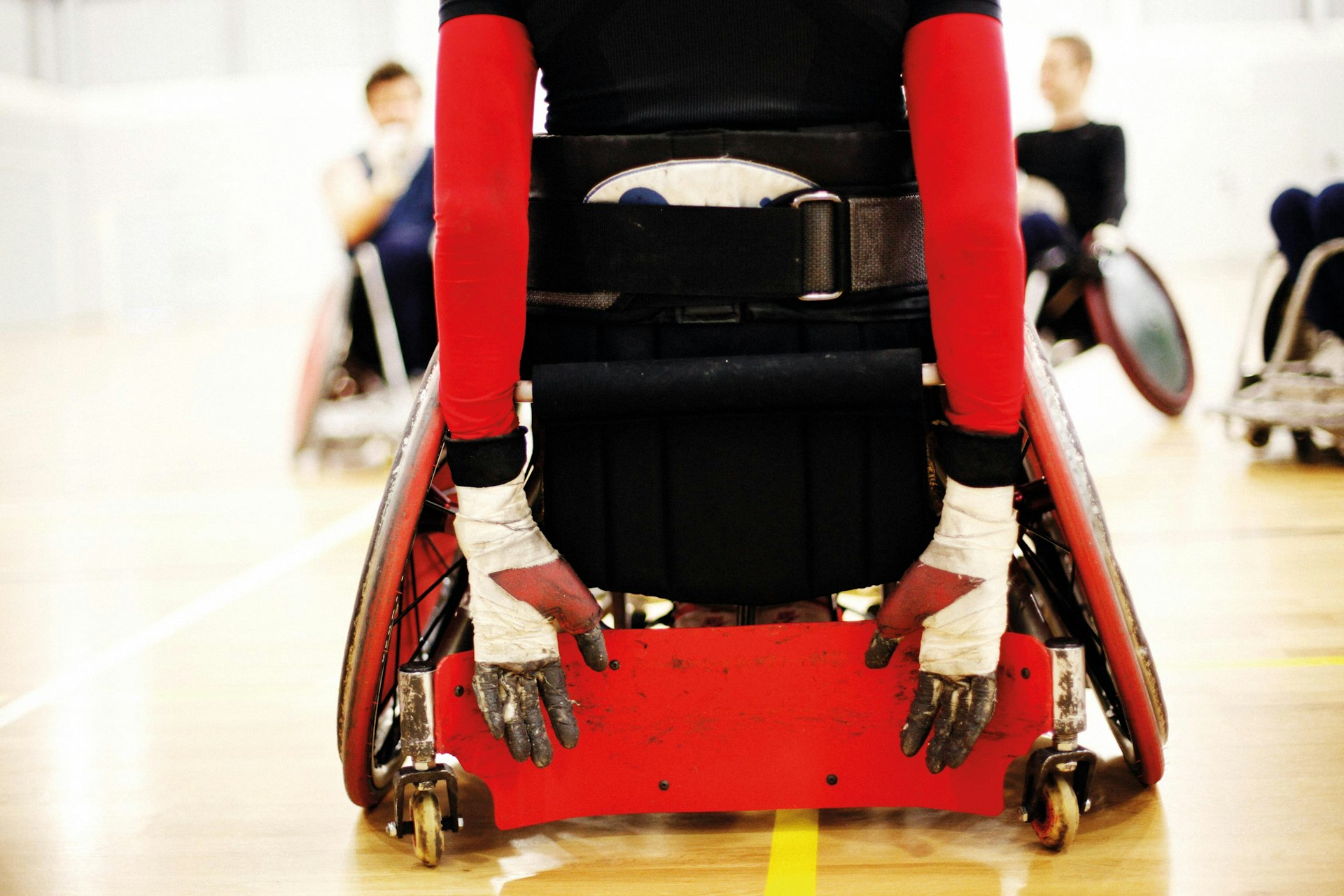
Intrigued, he asked the pair what it was like. “They looked at each other and they looked at me. Then they looked me up and down and said, ‘You’ve got to come and try it’.” Team GB had long been looking for an elusive ‘high pointer’. And while they didn’t know yet, they had just found one in Phipps.
Upon entering the murderball world, players effectively get a number stamped on their forehead based on how much of their body works. The system is based on a five-point scale. Someone with no injury would be a five and someone completely paralysed would be a zero.
Phipps is a 3.5, the highest classification allowed to play wheelchair rugby. The number means his spine has not been broken, but his four limbs are damaged. For others, the higher the break is up their spine, the less they can use their body and the lower their classification.
These numbers are crucial in the game because the combined points of the four players on the court cannot exceed eight. For every player like Phipps, a team needs someone like Team GB’s Jonny Coggan – a 0.5 nicknamed ‘The Silent Assassin’ for his knack of sneaking up on and stopping higher-classified players. Or Mike Kerr – a 1.5 who brings the streets of Glasgow to his game with an aggressive style that gets him knocked on his back often but also produces spectacular goals.
“It’s a bit bizarre, you spend your time with non-disabled people and you’re the only disabled one,” Phipps says. “Then you go into an environment where people tell you that you’re not disabled because you’re the 3.5 and you’ve got the most function.”
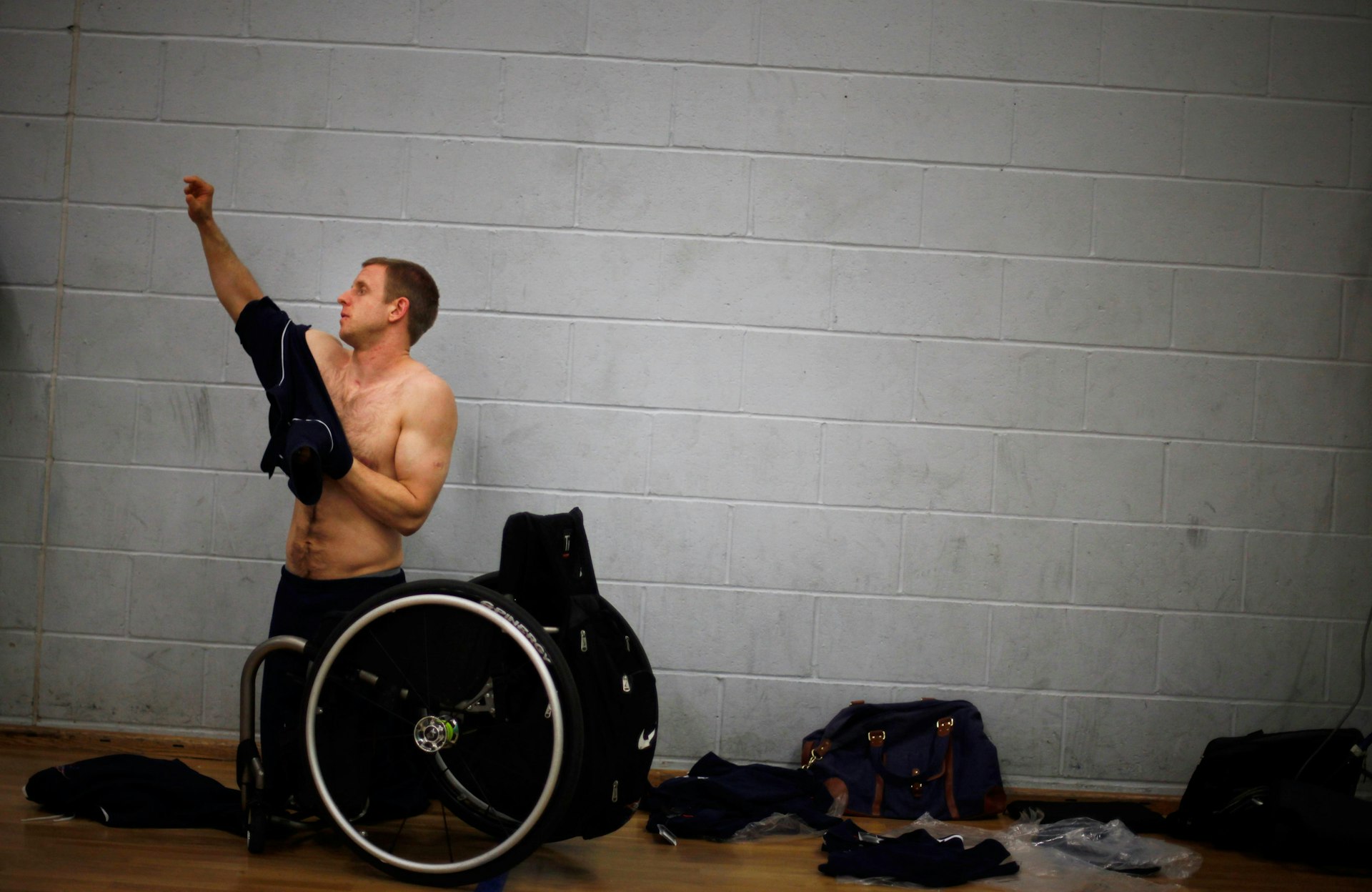
His Team GB debut was the 2009 European Championships. Despite being the rookie, he was expected to be the team’s enforcer and top scorer. “Meanwhile, I was thinking, ‘Oh my God. I’m playing against Denmark, I’m playing against Ireland and I haven’t got a clue what I’m doing.’”
But what he lacked in experience, he made up for in fitness. Trying to make sense of conflicting advice when he began racing, Phipps had consulted sports science Professor Stewart Bruce Lowe at Southampton’s Solent University.
Bruce Lowe saw huge potential in Phipps and now helps him train six days a week – as hard as an able-bodied Olympic athlete – doing speed work, weight training and team drills. In his kitchen, Phipps fixes a protein shake, opening a cupboard with photos of himself in action taped inside the door.
“One day when I wasn’t here, Stewart came by and put these up,” he explains. Beneath the photos, Bruce Lowe posted mantras: ‘Every ceiling, when reached, becomes a floor’ and ‘Champions are made from something they have deep inside them’.
Making Phipps meaner is another of Team GB’s challenges. As a career counsellor who works with school kids, he admits knocking people out of wheelchairs did not come naturally.
“As the 3.5, you are meant to be a big bully and I am a nice guy most of the time. But when I’m on court, I try to flick a switch and be something different. It brings out a dark side in me that I didn’t know I had,” he says.
“I’m bringing more and more of this dark side out. It’s a great feeling when you smash someone out of their chair. When you connect with someone just right and they go flying. I don’t want to hurt anybody, don’t get me wrong. It’s just for sport, but it is good. It’s the same when you’ve been knocked out as well. It’s no different from regular rugby,” he says.
The game often draws people in just as they are coming out of rehabilitation. After being surrounded by tenderness and caution, the sports’ aggression and fearlessness is, for many, a welcome antidote.
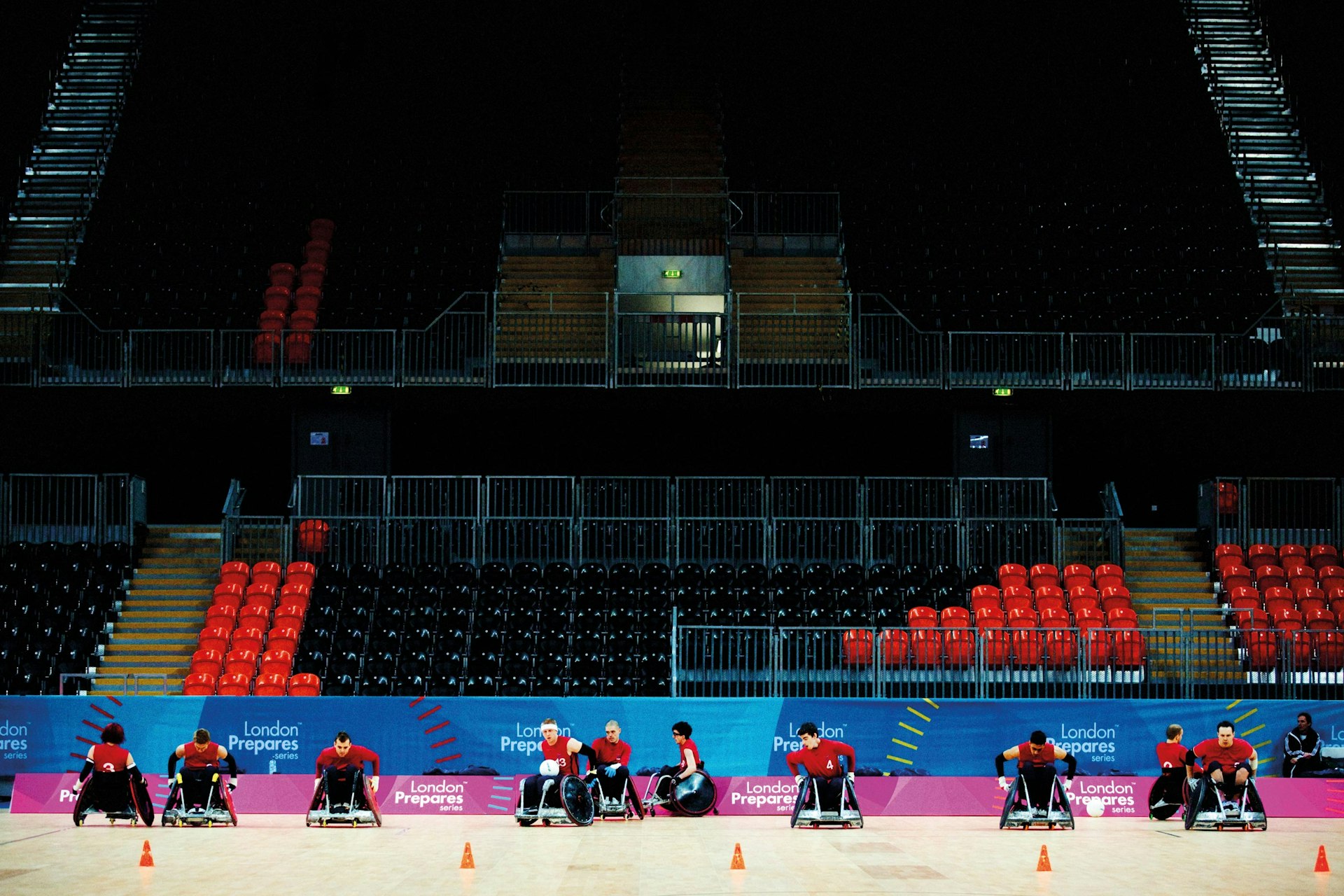
Team GB’s Kylie Grimes, whose career as a horse show jumper ended after a swimming pool diving accident, first saw the game while she was still in the spinal unit. She remembers the feeling of slipping into a rugby chair for the first time.
“I felt like I could do things again,” says the twenty-four-year-old. “You feel the hits all the way up your legs and into your head.” A 0.5, she is one of a handful of women competing at the international level. The men give her no breaks because she’s a woman, she says, adding “and I wouldn’t want them to.”
Back at the Olympic park, Team GB lines up for the test event final. They’re up against No.2-ranked Australia, a tough crew of guys with rugby player physiques, beefy with shaved heads and heavy tattoos. Britain looks smaller and leaner: Phipps in a John McEnroe headband, Grimes with hair dyed Union Jack red and thirty-five-kilogram Myles ‘The Killer’ Pearson sporting goggles and a big grin.
“They call us the misshapes,” Phipps jokes, “like broken biscuits.” Despite being the lowest-ranked team going into the tournament, Britain dominated the round robin stage to enter the final undefeated. But up to today’s test final, most teams are trying new line-ups of players and being careful not to reveal all their secrets. In their earlier game against Team GB, Australia rested its not-so-secret weapon, Ryley Batt.
Twenty-three-year-old Batt is the best wheelchair rugby player in the world. He was born without legs and needed surgery to give him two fingers on each hand. Until he was twelve, he refused to use a wheelchair because he did not consider himself disabled.
Instead he used a skateboard to get around, relying on his callused and scabbed hands as brakes. Wheelchair rugby found him when a wheelchair sports demonstration came to his school. His able-bodied classmates leapt at the chance to try, but Batt was adamant that he would not get into a chair.
After a week of mates raving about the rugby-meets-bumper cars experience, he gave in and hopped into a wheelchair for the first time. Soon he was at the Athens Games, competing as the youngest-ever member of the Australian squad.
After that performance, his original 2.5 rating was bumped up to 3.5. But Batt responded by raising the intensity of his game even higher.
From the first whistle, Phipps and Batt are on each other like fighting fish. Wearing a black headband, Phipps hits hard and often but is also knocked down repeatedly.
Batt also hits the floor after spinning himself out, but repeatedly blocks passes and grabs at the ball, stealing it away. Team GB keep fighting, but Australia manages to lock up Phipps. And sure enough, the Aussies’ lead grows and grows, ending with 71-48 on the scoreboard.
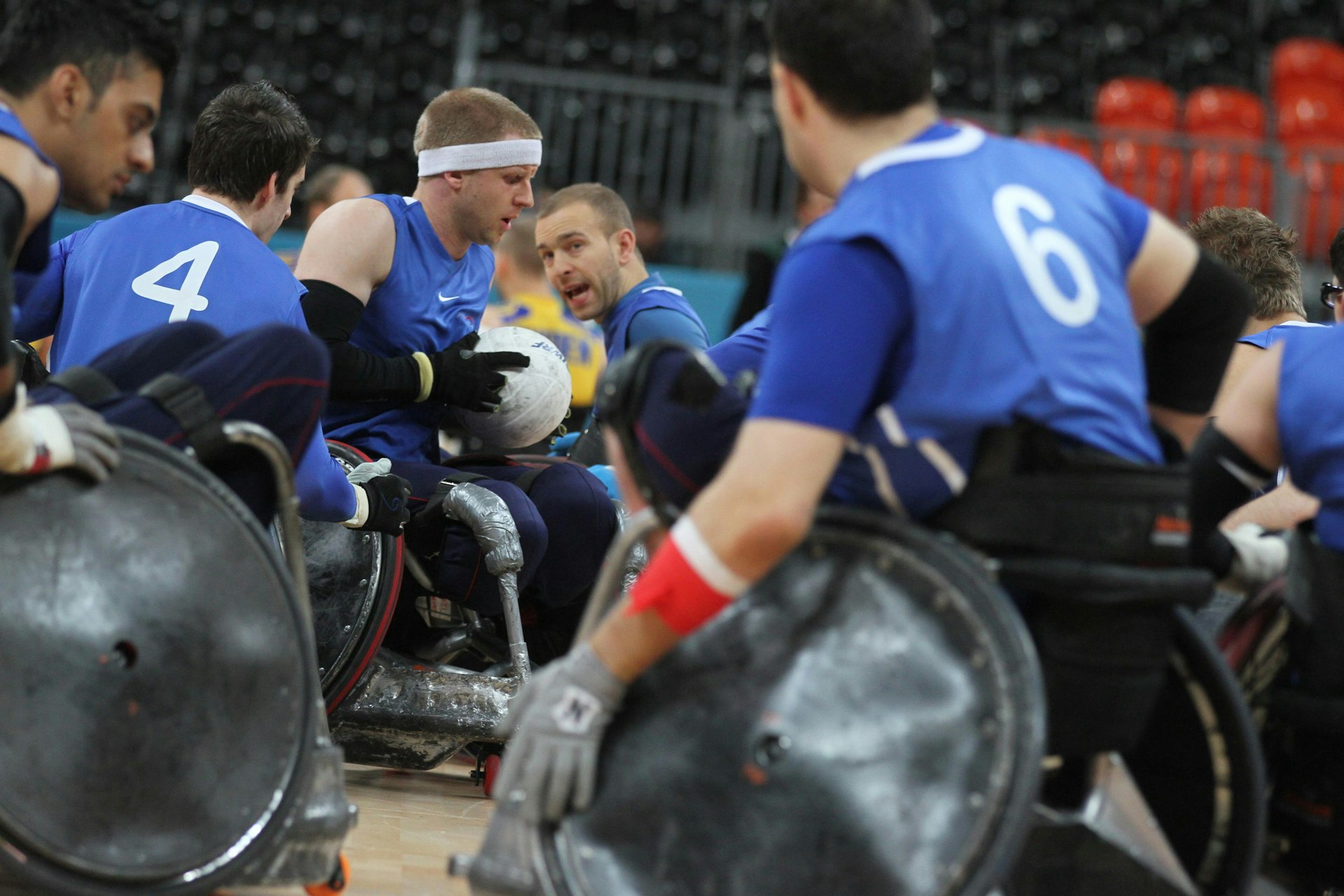
After the game, Batt admits he just witnessed a fiercer Team GB. And, by his estimation, they’re only going to get stronger. “Come the Paralympics,” he says, “they’re going to be a totally different team.”
Phipps, on the other hand, is keeping things in perspective. He sees the chance to perform on home soil in front of a 12,000-strong audience as a once in a lifetime opportunity – but he’s not getting carried away just yet.
“That was a hard lesson,” he says, coming off the court. “It shows how far we’ve come, but also how far we’ve got to go. No one is going to remember winning a test event. What matters is what lies ahead.”
This article originally appeared in Huck 33 – The Identity Issue. Subscribe today to make sure you never miss another issue.
Enjoyed this article? Like Huck on Facebook or follow us on Twitter.
